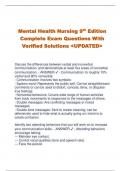Mental Health Nursing 9th Edition
Complete Exam Questions With
Verified Solutions <UPDATED>
Discuss the differences between verbal and nonverbal
communication, and demonstrate at least five areas of nonverbal
communication. - ANSWER ✔ - Communication: Is roughly 10%
verbal and 90% nonverbal.
- Communication involves two symbols:
- Spoken word: Represents the public self. Can be straightforward
comments or can be used to distort, conceal, deny, or disguise
true feelings.
- Nonverbal behaviors: Covers wide range of human activities
from body movements to responses to the messages of others.
- Double messages: Are conflicting messages or mixed
messages.
- Double-bind messages: Sent to create meaning; can be
defensively used to hide what is actually going on; intent is to
create confusion.
Identify two attending behaviors that you will work on to increase
your communication skills. - ANSWER ✔ - Attending behaviors
encourage talking.
--- Maintain eye contact.
--- Control vocal qualities (tone and speech rate).
--- Face the person.
,--- Use encouraging gestures.
--- Track verbal content; do not change the subject.
--- Use open-ended vs. closed-ended questions.
--- Asking why? may place a person on the defensive and cause
discomfort.
Relate problems that can arise when nurses are insensitive to
cultural differences in a patient's communication styles. -
ANSWER ✔ - Cultural Considerations: Negotiating Barriers
---- Four areas that may prove problematic for the nurse when
interpreting specific verbal and nonverbal messages of the patient
include the following:
1. Communication styles
2. Use of eye contact
3. Perception of touch
4. Cultural filters
Compare and contrast the range of verbal and nonverbal
communication of your cultural group with two other cultural
groups in the areas of (a) communication style,
(b) eye contact, and (c) touch. Give examples. - ANSWER ✔ Do
your own!!
Demonstrate with a classmate the use of four techniques that
can enhance communication, highlighting what makes them
effective. - ANSWER ✔ - The goals of the nurse in the mental
health setting are to help the patient:
--- Feel understood and comfortable.
--- Identify and explore problems relating to others.
--- Discover healthy ways of meeting emotional needs.
--- Experience satisfying interpersonal relationships.
Demonstrate with a classmate the use of four techniques that
can obstruct communication, highlighting what makes them
,ineffective. - ANSWER ✔ - Nontherapeutic Communication
Techniques
--- Giving premature advice
--- Minimizing feelings
--- Being falsely reassuring
--- Making value judgments
--- Asking excessive questions
--- Giving approval—agreeing
--- Disapproving—disagreeing
--- Changing the subject
Role play with a classmate the techniques of "What if" and "The
Miracle Question," and then switch roles. Identify what new
information you might have learned about your classmate and
what new insights you might have learned about yourself. -
ANSWER ✔ Projective Question: "What If..."
- Start with a what if question to help people articulate, explore,
and identify thoughts and feelings.
--- If you had three wishes, what would you wish for?
--- What if you could go back and change how you acted in (X
situation or significant life event)? What would you do differently
now?
--- What would you do if you were given $1 million, no strings
attached?
Projective questions can help people imagine thoughts, feelings,
and behaviors they might have in certain situations.
Presupposition Question:
"The Miracle Question"
--- Suppose you woke up in the morning and a miracle happened,
and this problem had gone away:
- What would be different?
, - How would it change your life?
These two questions can reveal a lot about a person that can be
used in identifying goals that the patient might be motivated to
work on. These questions often get to the crux
of what might be among the most important issues in a person's
thinking and life.
Frontal Lobes - ANSWER ✔ Controls voluntary body movement,
executive functions such as thinking, judgement, expression of
feelings
Parietal Lobes - ANSWER ✔ - Its primary function is associated
with language recognition
- Interprets sensory info: touch, pain, taste
Temporal Lobes - ANSWER ✔ Manages hearing, short-term
memory & sense of smell
Forebrain [Diencephalon] - ANSWER ✔ Is the relay center for
most sensory input from the PNS. Directs autonomic, endocrine &
motor function control, affects homeostasis, hearing, vision, smell,
taste & touch perception
- Includes the Thalamus, Hypothalamus, and Limbic System
Midbrain [Mesencephalon] - ANSWER ✔ Responsible for
integration of visual, auditory, and righting (balance) reflexes
Hindbrain - ANSWER ✔ Pons - centers for respiration,
Associated with sleep & dreaming
Medulla - Responsible for heart rate, respiration, and reflexes
Cerebellum - Concerned with involuntary movement




